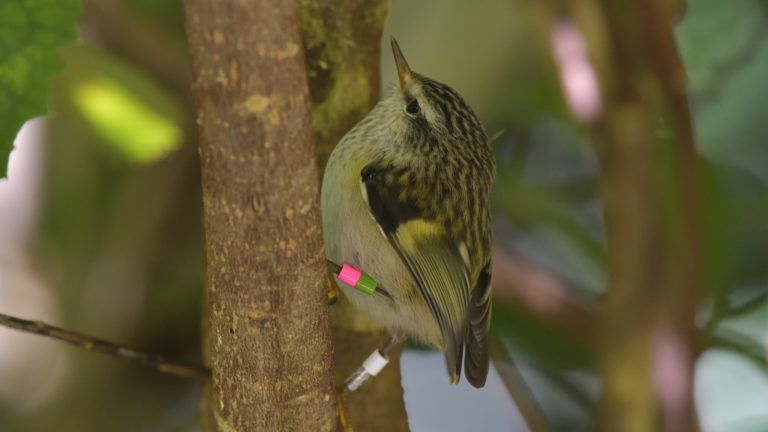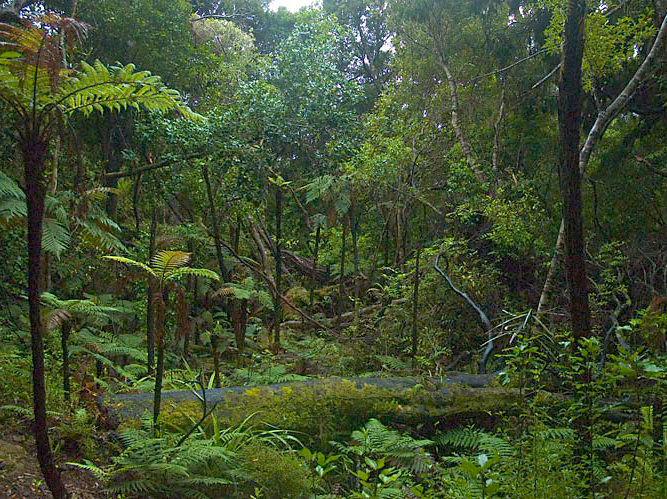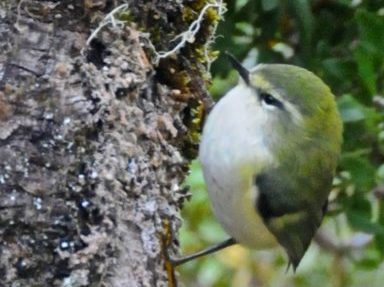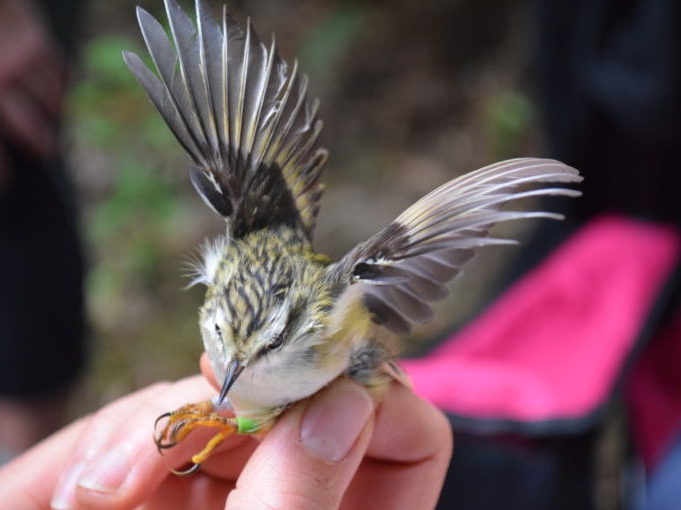Translocation is an important tool for conservation management – but it comes with risks. The capture and transfer process can be highly stressful to wildlife. Some individuals can and have died.

Finding ways to reduce translocation stress can save lives. And the lives that are saved are often those of rare and endangered taonga. So testing and documenting the strategies that work is hugely important.
Sarah Withers, Doug Armstrong, Tamsin Ward-Smith, Stuart Parsons and Mark Hauber monitored the translocation and establishment of the titipounamu (North Island rifleman) and report on actions that made a measurable difference in reducing translocation mortality. Their report has been published by Bird Conservation International.
“The capture and holding phases of a translocation are known to cause moderate to high levels of stress for most translocated individuals and the cumulative effects of stress can lead to reduced immune defence and metabolic or behavioural crises. The use of inappropriate capture, holding or release methodologies can exacerbate this problem, leading to high transfer-related mortality. Unfortunately, the species-specific methods and outcomes of many translocation attempts are not published. Consequently, reintroduction biologists have been emphasising the need for publication of both methods and results of translocations, regardless of the (positive or negative) outcome.”
Long-term issues can arise too, if the surviving founders are reduced in number to the point where they can’t establish a viable, long-term population.
“Despite the many successes, a high proportion of translocations fail to establish viable populations or reach the population size goals set by managers at the outset. Whereas multiple individual factors will contribute to the outcome of a translocation, transfer-related mortality (i.e. loss of life as a direct result of the capture/transfer/release processes) has a significant negative impact on potential population establishment as any reduction in the number of initial founders reduces the likelihood of population persistence.”
Being released into a totally new environment is also stressful for translocated individuals. There is the stress of being in an unfamiliar environment. There may also be inadequate food, competition from ‘the locals’ and predators to deal with.

“Losses during establishment are common and can further reduce the number of founders available to contribute to population growth and persistence.”
A small number of founders can also mean inbreeding and a lack of genetic variation.
“Reintroduction biologists advocate decision-making based on reliable and appropriate data collection, and robust modelling of population growth parameters. Modelling procedures can be used to address many specific management options, including requirements for supplementary transfers, predator control, and nest site or supplementary food provisioning. Monitoring and modelling of vital rates, including survival and reproduction, both during and following the establishment phase, is crucial for accurate reporting on the outcome of translocations, particularly for small establishing populations.”
The Hawkes Bay translocation followed an earlier translocation of the South Island rifleman where high mortality occurred. Plans were put in place to try and prevent similar deaths this time around. But why risk a translocation at all?
“This study reports on the transfer design and establishment of the first translocation of the North Island subspecies of an endemic New Zealand passerine, the rifleman (Acanthisitta chloris granti). The rifleman (Acanthisitta chloris) is one of only two remaining species within the ancient New Zealand wren family. Whereas the family originally consisted of seven species, five are now extinct. Both the North Island and South Island subspecies of rifleman have been described as locally common. However, decreasing population sizes and increasing population fragmentation mean that the North Island subspecies is becoming increasingly threatened. It is almost extinct throughout large areas of the North Island and is now described as locally threatened or extinct in some regions.”
The first translocation of South Island rifleman Acanthisitta chloris chloris occurred in 2003, where a small population from Codfish Island was moved to the mammalian predator free Ulva Island near Rakiura (Stewart Island).
“This translocation experienced high mortality during transfer, but the project was successful in establishing a continually viable breeding population and provided several key recommendations regarding future transfer methodology for the rifleman species. In particular, Leech et al. (2007) recommended reduced holding times, the separation of individuals from different family groups, and the supply of food and water during holding. In 2008, a privately funded and managed mainland (i.e. non-insular) sanctuary was approved as a recipient site for the first translocation of the North Island rifleman, providing an opportunity to apply the recommendations provided by Leech et al. (2007).”
Three translocations were carried out from 2008 to 2010. The researchers investigated whether implementation of Leech’s recommendations resulted in reduced transfer-related mortality, as was anticipated.
“The source site for translocation was the Boundary Stream Mainland Island (BSMI), located within the Maungaharuru range within the Eastern ranges of the North Island. BSMI is an 800-ha block of native forest that has been managed as a ‘mainland island’ site (i.e. a defined area typically protected by intensive invasive-mammal management) by the New Zealand Department of Conservation (DOC) since 1996. The site was selected as the most appropriate source location for two reasons; firstly, rifleman occur at high densities within the intensively managed site and the source population was predicted to recover in numbers swiftly after removal of the translocated birds. Secondly, the reserve is in close geographic proximity to the Cape Kidnappers peninsula, resulting in ease of physical access to, and familiarity with the area by catchers, and shorter transportation times.”
Cape Kidnappers and Ocean Beach Wildlife Preserve (CKOBWP), located on the Cape Kidnappers peninsula in the Hawke’s Bay region was the recipient translocation site.
“CKOBWP is a privately-funded conservation initiative on private land that aims to restore the peninsula with native flora and fauna characteristic of the region’s coastal system. Management of the site includes extensive mammalian pest control through trapping and poisoning, the maintenance of a 9.6-km predator-proof fence which spans the neck of the peninsula, and intensive reforestation efforts. A restoration plan has been developed to guide the reintroduction of native species to the peninsula, and the Rifleman was identified as one of four non-endangered endemic forest bird species absent from the area when the project began in 2007.”
Rifleman are thought to have once occurred in the area but have been absent for an unknown period of time, probably due to predation and deforestation. Before release, 130 artificial rifleman nest boxes were installed throughout the core area of the preserve where the birds were to be released.
Rifleman calls were recorded from the source site, one week before catching to be used as a lure.

“Rifleman were caught only on fine days and during daylight between 09h00 and 16h00. Several 25-mm gauge mist nets were positioned in known territories and playback of local rifleman calls was used to lure rifleman into the nets. Captured individuals were placed in black cotton holding bags and taken to a central processing site where they were physically examined, banded, weighed, and visually sexed from their dichromatic plumage, before being placed into individual small (210 mm x 150 mm x 150 mm) plywood holding/transfer boxes.”
The boxes were ventilated and contained perches, water and a plentiful supply of mealworms to eat. To minimise territorial stress, only one rifleman was placed into each holding box and only rifleman from the same family group were held within calling distance of each other.
“Rifleman were not disease screened during the transfer process to avoid prolonged handling and associated stress. All rifleman were transported and released on the same day of capture and time from capture to release did not exceed five hours. Water bowls were removed from boxes prior to transfer. Rifleman were either flown by helicopter to the release site (transfer time approximately 20 min) or were driven to the site by vehicle (transfer time approximately two hours). Three release sites connected by contiguous habitat were used (located a maximum of 1.5 km apart). Releases took place no later than 16h00 to allow birds to settle and feed before nightfall.”
For the next three years, the forested area surrounding the release site was surveyed once each breeding season.
“No individuals recorded as absent in one breeding were detected as present in a subsequent breeding season. We therefore assumed detection probability to be 100%; individuals not recorded were assumed to have died or dispersed outside the preserve. Most females identified during surveys were subsequently monitored throughout the breeding season, allowing reproductive success to be estimated by detecting juveniles from their calls, which are loud and distinct.”
The population data was analysed using an integrated approach in which survival, reproduction, and population dynamics were modelled simultaneously in order to predict the long-term viability of the population.
A total of 86 rifleman were caught during the 2008 (46) and 2010 (40) translocations. While all individuals survived capture and handling, three individuals died due to the transfer process.
“One individual did not survive the transfer and was found dead in the transfer box upon arrival, presumably from stress associated with handling and holding. An additional bird died shortly after arrival at the release site while still in the transfer box, and this death is also considered a result of the transfer. One individual was released alive but found dead several hours later and is considered to have died as a result of tail feather loss during capture and handling.”
“All other individuals survived the transfer, regardless of the method of transportation (helicopter or vehicle). However, individuals that were transported via helicopter were noticeably more alert and dispersed from boxes in a faster timeframe than those moved by vehicle.”
Some birds consumed all available food supplied to them, showing that food was an important resource during transfer. Not all individuals did so, however, regardless of the mode of transportation.
“Eleven of the 44 (25%) individuals successfully released in 2008 were found in the preserve in the first (2008–2009) breeding season, comprising six males and five females. Seven of the 39 birds (18%) transferred in 2010 were found in the following breeding season. Therefore, 22% of the birds remained in the preserve and survived from the transfer process up to their first local breeding season, assuming 100% detection.”
Individuals settled into territories within 500 m of the release sites and founders appeared to have paired by the first breeding season as all detected individuals were found in breeding units.
“Four breeding territories were located in both the first (2008–2009) and the second (2009–2010) seasons. Seven breeding territories were located in the third (2010–2011) season. Individuals appeared to maintain pair bonds throughout the winter, breeding with the same partner in subsequent breeding seasons, unless that partner disappeared. Offspring also appeared to establish territories with boundaries adjacent to the release site and to currently occupied territories, although a single male established a territory alone at a distance of 1.7 km from all other territories. Offspring born at the release site were observed to pair and establish territories almost immediately following independence.”
“Of the 11 birds (three first-year, eight age unknown) found in the first breeding season, six were found in the second breeding season, and two of these were found in the third breeding season. These data gave estimated survival probabilities of 0.56 and 0.39 for first-year and older adults, respectively.”
How did translocation mortality and longer-term survival compare with the earlier Ulva Island translocation of South Island rifleman?

“Leech et al. (2007) specifically recommended implementing reduced holding times, separation of different family groups, and an allowance for feeding time in the morning before capture and the afternoon following release. The adoption of these recommendations resulted in a transfer survival rate of 97% compared to 52% for the previous Ulva Island translocation. Mortality specifically during the capture, holding and release phases of the transfer process was significantly decreased in the CKOBWP translocation compared to the Ulva Island translocation, with a reduction in mortality from 48% to 3%.”
What was it about the way the original Ulva Island translocation was carried out, that might account for such a difference?
“Whereas the Ulva Island translocation required two separate capture episodes, with birds held temporarily in aviaries, the CKOBWP translocation used only a single handling episode and a single enclosure (individual transfer boxes). The separation of rifleman into individual holding boxes also appeared to be an effective technique for minimising the stress associated with forced interaction between territorial individuals. Leech et al. (2007) suggested that the losses associated with the holding phase of the transfer were the result of highly aggressive territorial interactions between non-familial individuals who were forced to share the same enclosures.”
The mealworms probably also helped.
“Rifleman, especially given their small size, are considered to be highly metabolically demanding, and spend a very high percentage of their time foraging (up to 82.5%). Therefore, longer holding times might be responsible for increased mortality as a direct result of a lack of sustenance. While food was provided during both the Ulva Island and CKOBWP translocations, individuals varied in their consumption during the CKOBWP translocation. As the stress response to capture and holding results in increases in both heart rate and energy mobilisation in birds, we suggest that some individuals might not be feeding enough during holding to compensate adequately for the increased metabolic rate produced by stress.”
Survival after release was still an issue however – and old forest vs new forest may have been part of the problem.
“While the revised transfer methodology described here appears to have decreased transfer associated mortality significantly, the re-sighting of translocated individuals post-transfer was low, indicating high post-release mortality and/or dispersal. Numerous reintroduction studies have noted considerable mortality following translocation. Translocated birds can be vulnerable due to post-release experiences in novel environments and with competitors and/ or predators. The habitat at CKOBWP is a regenerating environment with patchy areas of mature forest, surrounding dry riverbeds, and is likely to be suboptimal in comparison to the mature forest habitat at the source site, BSMI. Rifleman occupy mature forest in most natural populations.”
A normal trend of higher mortality over winter may have also impacted survival.
“Rifleman populations experience winter declines in natural populations, with losses of up to 35%; over-wintering mortality is sex-biased, with the number of females declining significantly more than that of males (41% compared to 29%), indicating that females incur higher overall annual losses than males.”
So what are the chances of this translocated population surviving into the longterm? Not so good, it seems.
“The low rates of juvenile survival and reproductive success found in our study also contribute to the population’s high likelihood of extinction in the medium to long term. Our estimate of juvenile survival (31%) is substantially lower than the estimated juvenile survival rate of 53–80% for the successfully established population of rifleman translocated to Ulva Island.”
“The population viability model employed here predicted a negative population trend for the population in the medium term and implies a low probability of success for this population. However, uncertainty in our estimates is high due to the small population size and missing subsets of demographic and monitoring data.”
At time of writing, the authors reported that the current status of the CKOBWP rifleman population was unknown.
“Anecdotal reports of a small number of individuals still present indicates that there may be a very low-density breeding population still present at the site. We strongly recommend the collection and reporting of frequent monitoring data following any translocation, allowing more accurate model development and population projections.”
The full article is published in Bird Conservation International. Only the abstract is freely available to non-subscribers.

